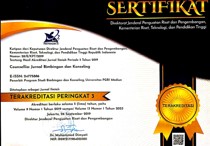VALIDITAS DAN RELIABILITAS WARWICK-EDINBURG MENTAL WELL BEING SCALE
Abstract
Penelitian ini melakukan uji validasi dan uji reliabilitas mengenai konsep kesejahteraan mental melalui skala well being Warwick-Edinburg. Kesejahteraan mental atau akrab disebut sebagai mental well being adalah kondisi seorang individu yang merasakan kenyamanan dalam mind setnya mengenai kondisi mentalnya. Oleh karena itu, kondisi kesejahteraan mental sifatnya flutuatif dan relative. Meskipun demikian menurut pandangan peneliti, tetap ada kemungkinan konstruk mengenai kesejahteraan mental ini dialami dan dirasakan sama lintas budaya dan beberapa tidak. Metode penelitian ini menggunakan tehnik confirmatory factor analysis untuk melakukan penyelidikan mengenai konstruk laten dalam kesejahteraan mental dan uji reliabilitas menggunakan composite reliability dari Raykov. Subjek berkisar 200 orang dengan latar belakang pendidikan mahasiswa dan pelajar, yang berusia remaja.Piranti lunak yang digunakan adalah R version 3.2.1 (2014-10-31) -- “Pumkin Helmet” dan Lisrel 8.8.Hasil penelitian menjelaskan bahwa ada beberapa indikator kesejahteraan mental yang tidak memnuhi standart dan gugur. Model dalam menjelaskan antara matrix kovarian data dengan teori juga terbilang kurang fit. Meskipun demikian uji reliabilitas tercapai koefisien yang signifikan dan layak.
Keyword: kesejahteraan mental, validitas, reliabilitas
Full Text:
PDFReferences
Anatasi, A., & Urbina, S. 1997. Psychological Testing (7th edition). New York: Macmillan
Angner, E. 2011. Subjective well – being. The Journal of Socio-Economics 39 (2010) 361–368.
Bartram, D, J. Yadegarfar, G. Sinclair, J, M, A. & Baldwin, D, S. 2011. Validation of the Warwick–Edinburgh Mental Well-being Scale (WEMWBS) as an overall indicator of population mental health and well-being in the UK veterinary profession.The Veterinary Journal 187 (2011) 397–398.
Bornstein, M, H. Davidson, L. Keyes, C, L, M.& Moore, K, A. 2003. Well-Being – Positive Development Accros The Life Course. Mahwah, New Jersey. Lawrence Erlbaum Associates, Inc.
Brown, T, A. 2006. Conformatory Factor Analysis for Applied Research. The Guilford Press. America, USA.
Feldt, L. S., &Brennan, R. L. 1989.Reliability. In R. H. Linn (Ed.), Educational measurement (3rd ed.). New York: Macmillan.
Gorard, S. & Taylor, C. 2004.Combining Methods in Educational and Social Research. USA. Open University Press McGraw-Hill Education.
Graham, J, M. 2006.Congeneric and (Essentially) Tau-Equivalent Estimates of Score Reliability What They Are and How to Use Them. Educational and Psychological Measurement. Volume 66, Number 6, December 2006 930-944
Hair, J.F, R.E. Anderson, R.L. Thatam, & W.C. Black. 1995. Multivariate Data Analysis With Reading, 4Thedition. Englewood Cliffs, NJ: Prentice Hall.
Harrington, D.2009. Confirmatory Factor Analysis. New York: Oxford University Press.
Hooper, D., Coughlan, J., & Mullen, M. 2008. Structural Equation Modelling : Guidelines for Determining Model Fit Structural equation modelling : guidelines for determining model fit. Journal of Business Research, 6, 53-60.
Humphreys, D, K. Goodman, A. & Ogilvie, D. 2013. Associations between active commuting and physical and mental wellbeing. Preventive Medicine, 57, (2013), 135 – 139.
Jackson, Y. 2006. Encyclopedia of Multicultural Psychology. Thousand Oaks, California. Sage Publication, Inc.
Jöreskog, K. G., & Sörbom, D. 2004. LISREL 8: User’s Reference Guide. Chichago: Scientific Software International.
Jorgensen, B, S. Jamieson, R, D, & Martin, J, F. 2010. Income, sense of community and subjective well-being: Combining economic and psychological variables. Journal of Economic Psychology 31 (2010) 612 – 623.
Keith, K, D. 2011. Cross-Cultural Psychology - Contemporary Themes and Perspectives. Willey – Blackwell. A John Wiley & Sons, Ltd., Publication
Kenny, D. A., Kashy, D. A., & Bolger, N. 1998. Data analysis in social psychology. In D. Gilbert, S. Fiske, & G. Lindzey (Eds.), The handbook of social psychology (Vol. 1, 4th ed., pp. 233-265). Boston, MA: McGraw-Hill.
Kline, R. B. 2011. Principles and Practice of Structural Equation Modeling (3rded). In David A. Kenny (Eds.), Methodology in the Social Sciences.New York: The Guilford Press.
Mason, P. & Kearns, A. 2013. Physical activity and mental wellbeing in deprived neighbourhoods. Mental Health and Physical Activity, 6 (2013), 111 – 117.
McGrath, R, E. 2011. Quantitative Model of Psychology. USA. Washington D. C. American Psychological Association, Press.
Moore, M. Bates, M, Brierley-Bwers, P. Taafe, P, & Clymer, R. 2012. Well Being and Its Measurement. Defence Centers of Excellent for Psychological Health and Traumatic Brain Injures.
Newbigging K, Bola M, Shah A: Scoping exercise with Black and minorityethnic groups on perceptions of mental wellbeing in Scotland. Scotland: NHSHealth; 2008. http://www.healthscotland.com/documents/2803.aspx.
Padilla, A. M., & Borsato, G. N. 2008. Issues in Culturally Appropriate Psychoeducational Assessment. In L. A. Suzuki, & J. G. Ponterotto (Eds.), Handbook Of Multicultural Assessment : Clinical, Psychological, and Educational Applications (3rd ed., pp. 5-21). New Jersey: John Willey & Sons.
Proctor, R, W. & Capaldi, E, J. 2006. Why Science Matters – Understanding The Methods of Psychological Research. USA. Blackwell Publishing.
Phye, G, D. Robinson, D, H. & Levin, J, R. 2005. Empirical Methods for Evaluating Educational Interventions. San Diego, USA. Elsevier Academic Press.
Rao, C, R. & Sinharay, S. 2007. The Handbook of Statistics on Psychometrics – Volume 26.USA. 2007 Elsevier B.V. All rights reserved.
Ryan, M, R. & Huta, V. 2009. Wellness of Healthy Functioning or Wellness as Happiness :the importance of eudemonic thinking. The Journal of Postive Psychology Vol 4, No.3, pp 202 – 204.
Ryan, M, R. & Deci, E, L. 2000. The “What” and “Why” of Goal Pursuits: Human Needs and the Self-Determination of Behavior. Psychological Inquiry, 2000, Vol 11, No 4, pp 227 – 268.
Raykov, T. 2007. Reliability if deleted, not ‘alpha if deleted’ : Evaluation of Scale Reliability Following Component Deletion. British Journal of Mathematical and Statistical Psychology (2007), 60, 201–216.
Raykov, T. 1997. Estimation of composite reliability for congeneric measures. Applied Psychological Measurement, 21, 173–184.
Robert, P. 2006. Reliability and validity in research.Journal ofNursing Standard. 20, 44, 41 – 45.
Rentfrow, P, J. Mellander, C. & Florida, R. 2009. Happy States of America: A state-level analysis of psychological, economic, and social well-being. Journal of Research in Personality 43 (2009) 1073–1082.
Sacolo, H, N. Chung, M, H. Chu, H. Liao, Y, M. Chen, C, H. Liang Ou, K. I Chang, L. & Chou, K, R. 2013. High Risk Sexual Behaviors for HIV among the In-SchoolYouth in Swaziland: A Structural Equation Modeling Approach. PLos ONE July 2013 | Volume 8 | Issue 7 | e67289.
Sawilowsky, S. S.2007. Construct Validity. In Neil J. Salkind (Eds.), Encyclopedia of Measurement and Statistics.(pp.178-180).
Shanafelt, T, D. Novotny, P. Johnson, M, E. Zhao, X. Steensma, D, P. Lacy, M, Q. Rubin, J. & Sloan, J. 2005. The Well-Being and Personal Wellness Promotion Strategies of Medical Oncologists in the North Central Cancer Treatment Group. Laboratory/Clinical Translational Research Oncology, 2005 ; 68: 23–32.
Shiraev, E, B. & Levy, D, A. 2010.Cross – Cultural Psychology – Critical Thinking and Contemporary Application. Boston, New York. Pearson Education, Inc., publishing as Allyn & Bacon.
Sireci, S. G. 2007. Content Validity.In Neil J. Salkind (Eds.), Encyclopedia of Measurement and Statistics (pp.181-183). Thousand Oaks: Sage Publications.
Snyder, C, R. & Lopez, S, J. 2002.Handbook of Positive Psychology. Oxford University Press
Socan, G. 2000. Assesment of Reliability When Test Items Are Not Essentially t-Equivalent. Developments in Survey Methodology Metodološki zvezki, 15, Ljubljana: FDV, 2000.
Taggart, F. Friede, T. Weich, S. Clarke, A. Johnson, M. & Stewart-Brown, S. 2013. Cross cultural evaluation of the Warwick- Edinburgh mental well-being scale (WEMWBS) –a mixed methods study. Health and Quality of Life Outcomes, 2013, 11:27.
Talbott, W, J. 2010. Human Right and Human Well Being. Oxford, New York. Oxford University Press, Inc.
Tennant, R. Hiller, L. Fishwick, R, Platt, S. Joseph, S, Weich S. Parkinson, J. Secker, J. & Stewart-Brown, S. 2007. The Warwick-Edinburgh Mental Well-being Scale (WEMWBS) : development and UK validation. Health and Quality of Life Outcomes 2007, 5:63.
Thompson, B. 2004. Exploratory and Confirmatory Factor Analysis – Understanding Concept and Applications. Washington, D.C. American Psychological Association.
Tokuda, Y. Doba, N. Butler, J, P. & Paasche-Orlow, M, K. 2009. Health literacy and physical and psychological wellbeing in Japanese adults. Patient Education and Counseling 75 (2009) 411–417.
Urbina, S. 2004. Essentials of Psychological Testing. New Jersey: John Willey & Sons.
Viera, A, L. 2011. Interactive LISREL in Practice – getting started with a SIMPLIS approach. Springer Heidelberg Dordrecht London New York.
Wajsblat, L, L. 2011. Positive Androgyny and Well Being : A Positive Psychological Perspective on Gender Role. Dissertation, Hemstead, Hofstra University.
Zapalla, C, R. 2007. Well Being : The Correlation Between Self Transcendence, Psychological and Subjective Well Being. Dissertation. Institute of Transpersonal Psychology Palo Alto, California October 25, 2007.
Article Metrics
Abstract has been read : 4637 timesPDF file viewed/downloaded: 0 times
DOI: http://doi.org/10.25273/counsellia.v6i2.1013
Refbacks
- There are currently no refbacks.
Counsellia is Indexed By:
Counsellia Office:
Universitas PGRI Madiun
Program Studi Bimbingan dan Konseling

This work is licensed under a Creative Commons Attribution-NonCommercial-ShareAlike 4.0 International License.














